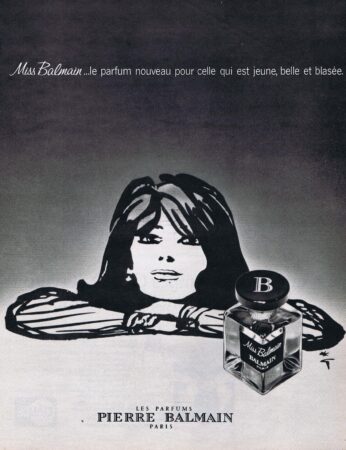
Vintage Miss Balmain ad, Rene Gruau 1968
These days, it’s not uncommon for classic fragrances to become lost amidst the shuffle of new releases which expands incrementally with each approaching year. Due to the rapid pace of life and ever-advancing technology we, the public – find our attention span to be briefer; we’re more easily distracted, in general.
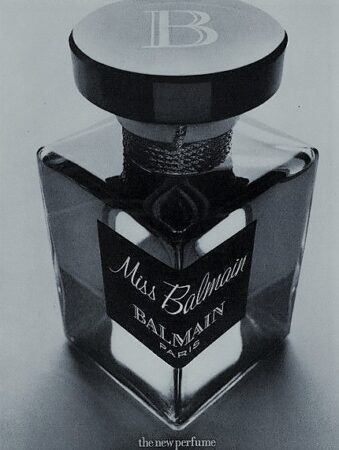
Art reflects the era/generation in which it is created; that which continues to resonate with us remains a staple heedless of the passage of time. As this applies to every creative venue imaginable, it also holds true for perfume. We may glimpse a bird’s eye view into a particular era simply by experiencing the fragrances composed at any specific time. 1967, the year in which Miss Balmain surfaced – was a time of social unrest and change which is reflected in this exquisitely rebellious perfume – carrying alongside it a steady wave of conservatism: a decade of vehement contrasts.

sisterhood campaign via the British Library
Examples of these contrasts are legion: civil rights moved forward with bold steps, embodied by the emergence of the Black Panther movement; race riots took place with increasing regularity. Women stormed the 60s in pursuit of equal rights, sexual liberation, and sisterhood; 1967 was part of the second wave of feminism. LGBTQ rights saw San Francisco assume pride of place as an epicenter for human rights and sexual orientation. That summer’s three-day Monterey Pop Festival foreshadowed the Woodstock of 1969. U.S. President Lyndon Baines Johnson was in office; both the Vietnam War and the Cold War were in full force, and the Space Race was at its zenith.
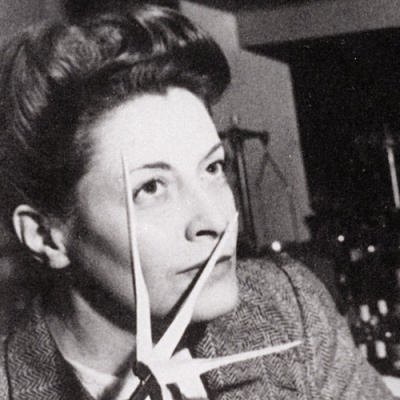
Germaine Cellier via Wiki
You may justifiably ask how Miss Balmain fits into this tempestuous time, or today’s world. To begin with, its very name is a misnomer: there’s little “miss” about it. In current day terms, the fragrance is comfortably genderless, and it most certainly is not girly, flirtatious, or frou-frou – any more than the original, elegantly bitter-mordant 1947 Miss Dior (created by Jean Carles and Paul Vacher 20 years prior) is. Miss Balmain may have been marketed to attract a more youthful clientele, but the proposed wearer bears nothing of the ingenue about their person.
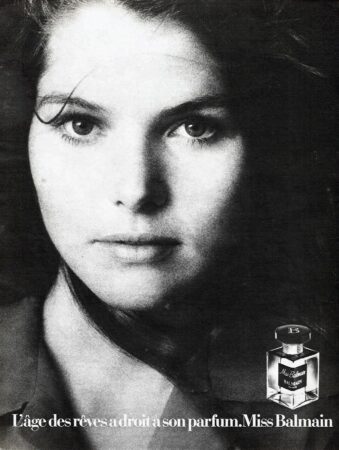
Lois Chiles in a Miss Balmain ad GETTY
Miss Balmain demands an individual of strong, decisive character – someone fearless and a mite reckless, truth be told. Unlike many other leathers, it doesn’t include violets, for one (as Mme. Cellier’s 1953 Jolie Madame does). As was fashionable at the time (and still is currently), it commences with a blast of aldehydes, brilliant citrus and spice (coriander and carnation), followed by a heady indolic bouquet which includes gardenia, narcissus, jasmine and jonquil – ripe with divine decay – in the company of orris and rose. Thujone, a powerful herbal fresh material found in clary sage, wormwood and various members of the juniper family – contributes that accent which ‘seasons’ florals with its piquancy (a helpful example of this aspect is to be found in original Miss Dior; it takes the form of clary sage). Miss Balmain’s base is out of this world, brimming with depth and mystery: leathery notes so dear to the nose, a darkly brooding amber burnished with winey patchouli, castoreum’s sweet/dry/tobacco-inferred muskiness, the inky, smoky intensity of oakmoss in companionable collusion with vetiver’s smoke-inflected verdancy. It comes as no surprise that, in the drydown – Miss Balmain assumes vestiges of a freshly-stubbed fine cigarette, the inside of a leather purse or bag littered with loose blond tobacco: this is part of its appeal, and a quality which feels familiar and undeniably sophisticated. There is an effortless, je m’en fiche (read: “I don’t give a damn”) quality to Miss Balmain, a wonderful inherent wildness that prowls subversively, despite being cloaked in refinement. An original for the original.
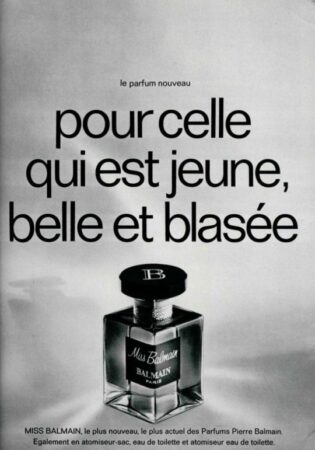
via wiki
Miss Balmain was the last perfume created by Germaine Cellier at the Roure Bertrand Dupont (now part of Givaudan) fragrance house where she and the brilliant Jean Carles (Canoe, Ma Griffe, Tabu, Shocking de Schiaparelli) fought like cats and dogs. Despite their bickering, there clearly was a measure of lurking admiration, as both Miss Dior and Miss Balmain share similar scented tendrils: both are verdant, with the Dior opening being greener and the drydown mossier yet bright – as opposed to Miss Balmain’s more effulgently floral introduction and darkly brooding denouement.
The timelessness of such a fragrance happens to be entwined with today’s turbulent landscape of change: in 2023, as in 1967 – we find ourselves in the midst of transition on a large scale. It’s remarkable that Miss Balmain feels as relevant today as it did then – iconoclastic, irrepressible and wearable for seditious souls wherever they may find themselves.
~ Ida Meister, Deputy and Natural Perfumery Editor
